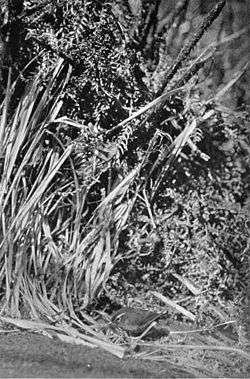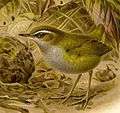Bushwren
| Bushwren | |
|---|---|
 | |
| Photo of a live X. l. longipes taken in 1911 | |
| Scientific classification | |
| Kingdom: | Animalia |
| Phylum: | Chordata |
| Class: | Aves |
| Order: | Passeriformes |
| Suborder: | Acanthisitti |
| Family: | Acanthisittidae |
| Genus: | Xenicus |
| Species: | X. longipes |
| Binomial name | |
| Xenicus longipes (Gmelin, 1789) | |
The bushwren (Xenicus longipes), bush wren, or mātuhituhi in Maori, was a very small and almost flightless bird that was endemic to New Zealand.
Description
It grew to about 9 cm long and 16 g in weight. It fed mostly on invertebrates which it captured by running along the branches of trees. It nested on or near the ground.
Extinction
It was widespread throughout the main islands of the country until the late 19th century when mustelids were introduced and joined rats as invasive mammalian predators. The only authenticated reports of the North Island subspecies (X. l. stokesi) since 1900 were from the southern Rimutaka Range in 1918 and the Ureweras up to 1955, with probable sightings on June 13, 1949, near Lake Waikareiti, and several times in the first half of the 20th century in the Huiarau Range, and from Kapiti Island in 1911 (Edgar, 1949; St. Paul & McKenzie, 1977; Miskelly, 2003). Apparently, the last population lived in the area where Te Urewera National Park was established, ironically just around the time of its extinction.
The last authenticated reports of the South Island subspecies (X. l. longipes) were from Arthur's Pass in 1966 and Nelson Lakes National Park in 1968. There have been a few unsubstantiated reports since then from Fiordland and Nelson Lakes.
The third subspecies, X. l. variabilis or Stead's bushwren, was found on Stewart Island/Rakiura and nearby islands. It is known to have survived on Stewart Island until 1951 (Dawson, 1951) but was probably exterminated by feral cats. It lived on Kotiwhenua (Solomon) Island, being reasonably common, until the early 1960s. It survived on predator-free Big South Cape Island until black rats (R. rattus) invaded it in 1964. The New Zealand Wildlife Service attempted to save the species by relocating all the birds they could capture. They caught six birds and transferred them to Kaimohu Island where they did not survive and died in 1972.
Gallery
 Illustration of Xenicus longipes longipes by John Gerrard Keulemans
Illustration of Xenicus longipes longipes by John Gerrard Keulemans Eggs of X. l. longipes in 1911
Eggs of X. l. longipes in 1911
Notes
- ↑ BirdLife International (2012). "Xenicus longipes". IUCN Red List of Threatened Species. Version 2013.2. International Union for Conservation of Nature. Retrieved 26 November 2013.
References
- Dawson, E. W. (1951): Bird Notes from Stewart Island. Notornis 4(6): 146-150. PDF fulltext
- Edgar, A. T. (1949): Winter Notes on N.Z. Birds. New Zealand Bird Notes 3(7): 170-174. PDF fulltext
- Miskelly, Colin (2003): An historical record of bush wren (Xenicus longipes) on Kapiti Island. Notornis 50(2): 113–114. PDF fulltext
- St. Paul, R. & McKenzie, H. R. (1977): A bushman's seventeen years of noting birds. Part F (Conclusion of series) - Notes on other native birds. Notornis 24(2): 65–74. PDF fulltext
External links
| Wikimedia Commons has media related to Xenicus longipes. |
| Wikispecies has information related to: Xenicus longipes |
- 3D view of specimen RMNH 110.000 at Naturalis, Leiden (requires QuickTime browser plugin).
- Paratype specimen of Xenicus longipes variabilis in the collection of the Museum of New Zealand Te Papa Tongarewa
- Image of Bush Wren from Te Ara: The Online Encyclopedia of New Zealand
- Photography of Xenicus longipes by William Herbert Guthrie-Smith
- Bush Wren / Matuhi. Xenicus longipes. by Paul Martinson. Artwork produced for the book Extinct Birds of New Zealand, by Alan Tennyson, Te Papa Press, Wellington, 2006

